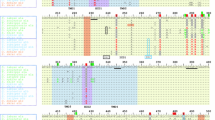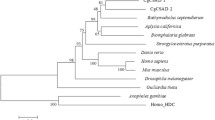Abstract
Taurine is the primary osmolyte in marine molluscs, whose cellular osmo-conforming process is vital for environmental adaptation because of a lack of osmotic homeostasis. Here, cDNA cloning and expression, and functional analyses of taurine transporter (TAUT) from the giant Pacific oyster are reported on. The deduced amino-acid sequence of oyster TAUT (oy TAUT) showed 47–51% identity to those of vertebrate TAUT, whereas identity among the vertebrates is 78–95%. Functional analysis of oyTAUT expressed in Xenopus oocytes revealed that oyTAUT has a lower affinity and specificity for taurine and a requirement for higher NaCl concentration, compared with vertebrate TAUT. Taken together with similar functional properties of TAUT from mussel, indicated by our previous study, it is possible that these functional features reflect the internal environment of the molluscs (i.e. higher taurine and NaCl concentrations). Oyster taurine transporter mRNA expression was induced by not only hyper-osmotic stress, similar to other TAUT, but also hypo-osmotic stress. It is speculated that the expression in response to hypo-osmotic stress was induced by a substantial decrease in tissue taurine content following the decrease in the internal osmolality.
Similar content being viewed by others
References
Hochachka PW, Somero GN. Biochemical Adaptation, Mechanism and Process in Physiological Evolution. Oxford University Press, New York, 2002.
Yancey PH, Clark ME, Hand SC, Bowlus RD, Somero GN. Living with water stress: evolution of osmolyte systems. Science 1982; 217: 1214–1222.
Somero GN, Bowlus RD. Osmolytes and metabolic end products of molluscs: the design of compatible solute systems. In: Hochachka PW (ed.). Environmental Biochemistry and Physiology, the Mollusca: Vol. 2. Academic Press, London, 1983; 77–100.
Hosoi M, Kubota S, Toyohara M, Toyohara H, Hayashi I. Effect of salinity change on free amino acid content in Pacific oyster. Fish. Sci. 2003; 69: 395–400.
Neufeld DS, Wright SH. Basolateral transport of taurine in epithelial cells of isolated, perfused Mytilus californianus gills. J. Exp. Biol. 1995; 198 (Pt 2): 465–473.
Huxtable RJ. Physiological actions of taurine. Physiol. Rev. 1992; 72: 101–163.
Fievet B, Gabillat N, Borgese F, Motais R. Expression of band 3 anion exchanger induces chloride current and taurine transport: structure-function analysis. EMBO J. 1995; 14: 5158–5169.
Takeuchi K, Toyohara H, Kinoshita M, Sakaguchi M. Ubiquitous increase in taurine transporter mRNA in tissues of tilapia (Oreochromis mossambicus) during high-salinity adaptation. Fish Physiol. Biochem. 2000; 23: 173–182.
Liu QR, Lopez-Corcuera B, Nelson H, Mandiyan S, Nelson N. Cloning and expression of a cDNA encoding the transporter of taurine and beta-alanine in mouse brain. Proc. Natl. Acad. Sci. USA 1992; 89: 12 145–12 149.
Smith KE, Borden LA, Wang CH, Hartig PR, Branchek TA, Weinshank RL. Cloning and expression of a high affinity taurine transporter from rat brain. Mol. Pharmacol. 1992; 42: 563–569.
Uchida S, Kwon HM, Yamauchi A, Preston AS, Marumo F, Handler JS. Molecular cloning of the cDNA for an MDCK cell Na(+)- and Cl(-)-dependent taurine transporter that is regulated by hypertonicity. Proc. Natl. Acad. Sci. USA 1992; 89: 8230–8234.
Jhiang SM, Fithian L, Smanik P, McGill J, Tong Q, Mazzaferri EL. Cloning of the human taurine transporter and characterization of taurine uptake in thyroid cells. FEBS Lett. 1993; 318: 139–144.
Ramamoorthy S, Leibach FH, Mahesh VB, Han H, Yang-Feng T, Blakely RD, Ganapathy V. Functional characterization and chromosomal localization of a cloned taurine transporter from human placenta. Biochem. J. 1994; 300 (Pt 3): 893–900.
Miyamoto Y, Liou GI, Sprinkle TJ. Isolation of a cDNA encoding a taurine transporter in the human retinal pigment epithelium. Curr. Eye Res. 1996; 15: 345–349.
Vinnakota S, Qian X, Egal H, Sarthy V, Sarkar HK. Molecular characterization and in situ localization of a mouse retinal taurine transporter. J. Neurochem. 1997; 69: 2238–2250.
Han X, Budreau AM, Chesney RW. Molecular cloning and functional expression of an LLC-PKI cell taurine transporter that is adaptively regulated by taurine. Adv. Exp. Med. Biol. 1998; 442: 261–268.
Qian X, Vinnakota S, Edwards C, Sarkar HK. Molecular characterization of taurine transport in bovine aortic endothelial cells. Biochim. Biophys. Acta 2000; 1509: 324–334.
Takeuchi K, Toyohara H, Sakaguchi M. A hyperosmotic stress-induced mRNA of carp cell encodes Na(+)-and CI(-)-dependent high affinity taurine transporter. Biochim. Biophys. Acta 2000; 1464: 219–230.
Palacin M, Estevez R, Bertran J, Zorzano A. Molecular biology of mammalian plasma membrane amino acid transporters. Physiol. Rev. 1998; 78: 969–1054.
Livingstone DR, Widdows J, Fieth P. Aspects of nitrogen metabolism of the common mussel Mytilus edulis: adaptation to abrupt and fluctuating change in salinity. Mar. Biol. 1979; 53: 41–55.
Hosoi M, Takeuchi K, Sawada H, Toyohara H. Expression and functional analysis of mussel taurine transporter, as a key molecule in cellular osmoconforming. J. Exp. Biol. 2005; 208: 4203–4211.
Turner DL, Weintraub H. Expression of achaete-scute homolog 3 in Xenopus embryos converts ectodermal cells to a neural fate. Genes Dev. 1994; 8: 1434–1447.
Utsunomiya-Tate N, Endou H, Kanai Y. Cloning and functional characterization of a system ASC-like Na+-dependent neutral amino acid transporter. J. Biol. Chem. 1996; 271: 14 883–14 890.
Krogh A, Larsson B, von Heijne G, Sonnhammer EL. Predicting transmembrane protein topology with a hidden Markov model: application to complete genomes. J. Mol. Biol. 2001; 305: 567–580.
Miyamoto Y, Balkovetz DF, Leibach FH, Mahesh VB, Ganapathy V. Na++Cl−-gradient-driven, high-affinity, uphill transport of taurine in human placental brushborder membrane vesicles. FEBS Lett. 1988; 231: 263–267.
Miyamoto Y, Tiruppathi C, Ganapathy V, Leibach FH. Active transport of taurine in rabbit jejunal brush-border membrane vesicles. Am. J. Physiol. 1989; 257: G65-G72.
Uchida S, Kwon HM, Preston AS, Handler JS. Expression of Madin-Darby canine kidney cell Na(+)-and Cl(−)-dependent taurine transporter in Xenopus laevis oocytes. J. Biol. Chem. 1991; 266: 9605–9609.
Sardella BA, Matey V, Cooper J, Gonzalez RJ, Brauner CJ. Physiological, biochemical and morphological indicators of osmoregulatory stress in ‘California’ Mozambique tilapia (Oreochromis mossambicus × O.urolepis hornorum) exposed to hypersaline water. J. Exp. Biol. 2004; 207: 1399–1413.
Zurburg W, DeZwaan A. The role of amino acids in anaerobiosis and osmoregulation in bivalves. J. Exp. Zool. 1981; 215: 315–325.
Pacioretty L, Hickman MA, Morris JG, Rogers QR. Kinetics of taurine depletion and repletion in plasma, serum, whole blood and skeletal muscle in cats. Amino Acids 2001; 21: 417–427.
Delaney SJ, Kass PH, Rogers QR, Fascetti AJ. Plasma and whole blood taurine in normal dogs of varying size fed commercially prepared food. J. Anim. Physiol. Anim. Nutr. (Berl.) 2003; 87: 236–244.
Cuisinier C, Michotte De Welle J, Verbeeck RK, Poortmans JR, Ward R, Sturbois X, Francaux M. Role of taurine in osmoregulation during endurance exercise. Eur. J. Appl. Physiol. 2002; 87: 489–495.
Lobo MV, Alonso FJ, del Rio RM. Immunohistochemical localization of taurine in the male reproductive organs of the rat. J. Histochem. Cytochem. 2000; 48: 313–320.
Lobo MV, Alonso FJ, Latorre A, del Rio RM. Immunohistochemical localization of taurine in the rat ovary, oviduct, and uterus. J. Histochem. Cytochem. 2001; 49: 1133–1142.
Burg MB, Kwon ED, Kultz D. Regulation of gene expression by hypertonicity. Annu. Rev. Physiol. 1997; 59: 437–455.
Dmitrieva NI, Burg MB. Hypertonic stress response. Mutat. Res. 2005; 569: 65–74.
Lynch MP, Wood L. Effect of environmental salinity on free amino acids of Crassostrea virginica (Gmelin). Comp.-Biochem. Physiol. 1966; 19: 783–790.
Gills R. Osmoregulation in three molluscs: Acanthochitona-discrepans (Brown), Glycymeris glycymeris (L.) and Mytilus edulis (L.). Biol. Bull. Mar. Biol. Lab., Woods Hole 1972; 142: 25–35.
Heavers BW, Hammen CS. Fate of endogenous free amino acids in osmotic adjustment of Crassostrea virginica (Gmelin). Comp. Biochem. Physiol. 1985; 82A: 571–576.
Han X, Budreau AM, Chesney RW. Adaptive regulation of MDCK cell taurine transporter (pNCT) mRNA. transcription of pNCT gene is regulated by external taurine concentration. Biochim. Biophys. Acta 1997; 1351: 296–304.
Han X, Budreau AM, Chesney RW. Functional expression of rat renal cortex taurine transporter in Xenopus laevis oocytes: adaptive regulation by dietary manipulation. Pediatr. Res. 1997; 41: 624–631.
Author information
Authors and Affiliations
Corresponding author
Rights and permissions
About this article
Cite this article
Hosoi, M., Shinzato, C., Takagi, M. et al. Taurine transporter from the giant Pacific oyster Crassostrea gigas: function and expression in response to hyper- and hypo-osmotic stress. Fish Sci 73, 385–394 (2007). https://doi.org/10.1111/j.1444-2906.2007.01346.x
Received:
Accepted:
Issue Date:
DOI: https://doi.org/10.1111/j.1444-2906.2007.01346.x




